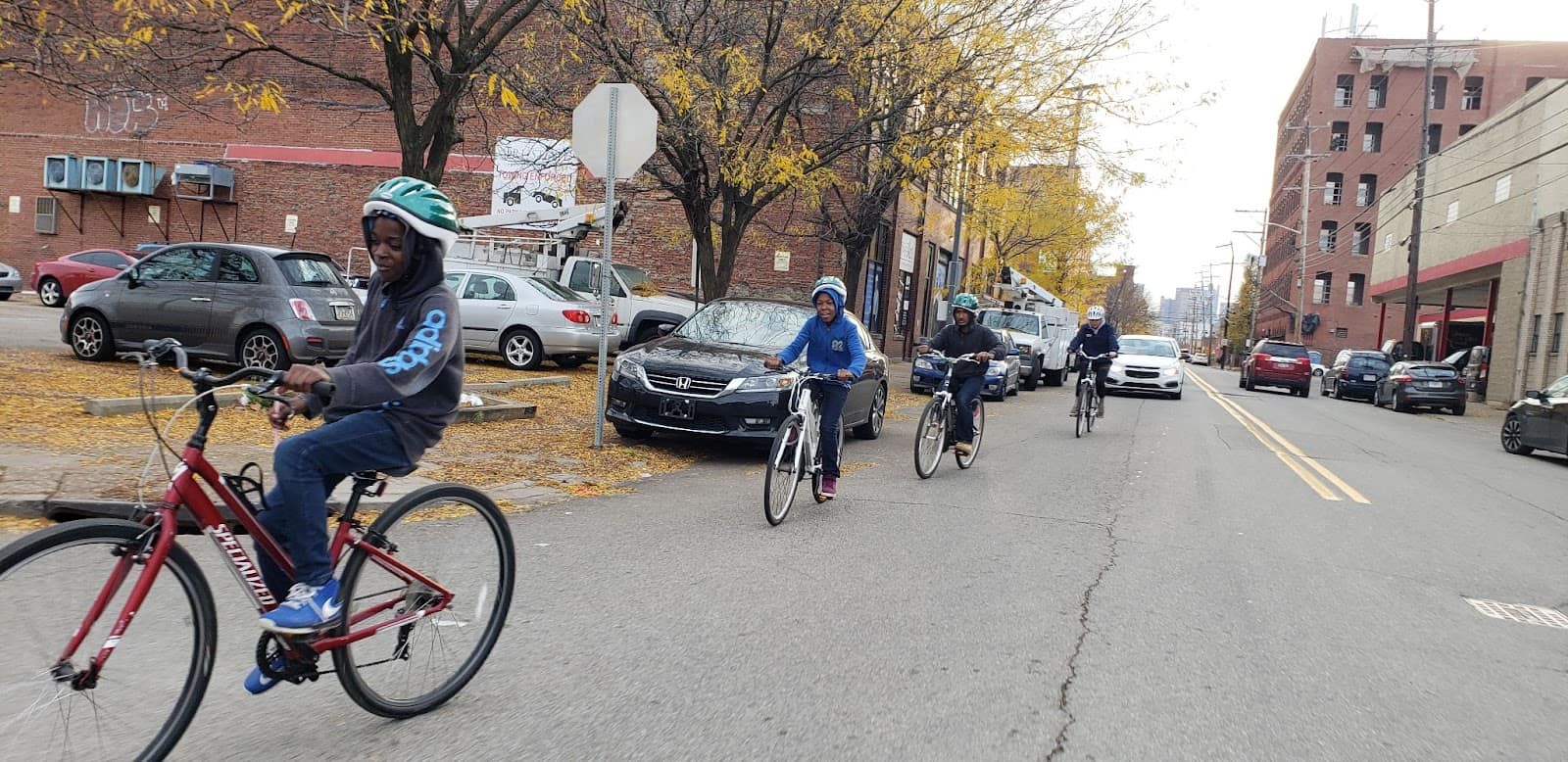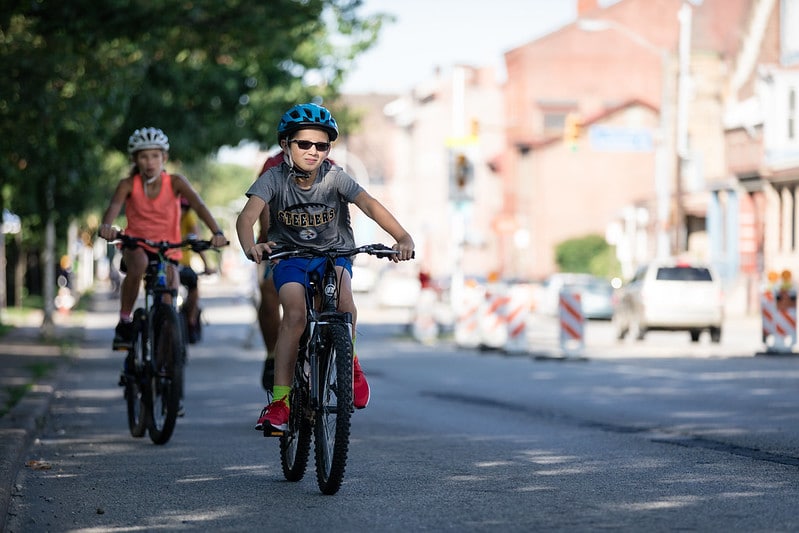
Safe Routes to School Needed Now More than Ever
As The Pittsburgh Post Gazette recently reported, due to the ongoing shortage of school bus drivers, many more Pittsburgh Public School students will be required to walk or bike to school this fall than in years past and cover greater distances. This local issue highlights a national problem and a worrisome trend. Although the physical, emotional, and psychological benefits of walking, biking, and other forms of active transportation are well-documented, many school students lack routes to school that are safe or easy to navigate.
According to the National Household Travel Survey, in the past fifty years, the number of students biking and walking to school has plummeted from 42% in 1969 to 10.4% in 2019. At the same time, health and psychological problems related to physical inactivity in children have increased. Unfortunately, some local schools are sited far from their students’ homes or in areas without traffic calming or consistent pedestrian and bicycle infrastructure – in some cases without sidewalks whatsoever.
The lack of safe streets around schools in our cities denies children the benefits of active transportation and the freedom to get to school on their own. However, the lack of safe routes to school as well as the lack of access to parks, green spaces, and safe bike and pedestrian infrastructure do not affect all students equally; instead, they are part of larger systemic inequities that disproportionately affect Black, brown, and low-income students.
The Lack of Safe Routes to School Disproportionately Affect Black, Brown, and Low-Income Students
According to the Safe Routes to School Partnership:
Children from families with low income, who are twice as likely to walk to school, disproportionately face more traffic and personal safety challenges while en route to/from school (McDonald, 2008). Black and Latino people are twice as likely to be killed while walking (Maciag, 2014). Black people are 30% more likely to be killed biking, and Latino people are 23% more likely to be killed biking (League of American Bicyclists, 2013).
As BikePGH recently blogged, this pattern of inequity has been exacerbated by infrastructural neglect in some communities while new bike and pedestrian amenities are often focused around newer and higher-income developments. Whereas communities with complete streets designed for the safety of all users reap the myriad benefits of active transportation to school, often Black, brown, and low-income families face a disproportionate share of the risk.
In some neighborhoods “hazard busing” is required on otherwise walkable distances when routes are deemed too dangerous for students. The safety of these routes in particular comes into focus when bus shortages, such as Pittsburgh’s, force students to walk them for the first time.
It Doesn’t Have to Be This Way
As Safe Routes Partnership has argued, policy change can encourage safe active transportation instead of an overreliance on busing around preventable hazards.
“Good models for local policies around school transportation focus not just on busing, but also on the safety of children who walk and bicycle to and from school. Many of these models set conditions for the determination of safe walking zones – or on the contrary, areas that are unsafe for walking and bicycling, resulting in those children being bused. In the most proactive approach, local communities can seek to fix those safety issues, allowing children to walk and bicycling again, and reducing busing costs.”
Locally, BikePGH and Pittsburgh’s Department of Mobility and Infrastructure’s Safe Routes to School Program are advocating for active transportation options for students and working to promote safe habits for young walkers and bicyclists while demanding safer streets to our schools.
Another way that Pittsburgh’s Safe Routes to School (SRTS) program is supporting students is by conducting walking audits of school neighborhoods to determine areas in need of crossing guards or larger infrastructural improvements such as bike lanes, bike racks, or traffic calming devices. Pittsburgh’s Safe Routes to School program is also working to compile safe routes for biking and walking to school in a kid-friendly map.

Get Involved!
Want to help create safe routes to school for your own children? Get started with the SRTS Guide, log 311 bike and pedestrian hazards with the MyBurgh App, join or start a neighborhood bike-ped committee, or team up with other families to create your own neighborhood walking school bus or bike train!
Learn more about the Safe Routes Partnership and check out their wealth of resources here.
Become a Navigation Ambassador and help students get to school
A+ Schools is working with the district to station adults at various locations to help students that will be walking or taking PAT busses for the first time to get to school.
Start Date: Friday, September 3, 2021
End Date: October 15, 2021
Hours: 6:30-8:30 am and 2:30 – 4:30 pm
Locations: Various throughout the City
Pay: $15/hr
Role: Pittsburgh Learning Collaborative Navigation Ambassadors will provide a warm and welcome face for students who may be walking or riding the bus for the first time to school. Unlike a crossing guard, the Navigation Ambassador will provide students information about bus transfers and encouragement to get to school.
Applicants are encouraged to send an email (copy and paste below) to Graham Mulqueen (gmulqueen@aplusschools.org) with:
Name
Address
Cell Phone
Short statement of what you would bring to the role of Navigation Ambassador
Languages spoken in addition to English
Preferred location for service (Downtown, Hill District, South Pittsburgh Hilltop, or other)
Please include a copy of your most recent Act 33/34 child clearance certificate.
Decisions will be made on a rolling basis.
A 2-hour training session, for which you will be compensated, will be mandatory for all Navigation Ambassadors. The first scheduled training will be Thursday, September 2, 2021 from 6-8 pm.
Subscribe to our newsletter for the latest updates!
Sign up for Bike Pittsburgh’s newsletter, The Messenger. It goes out bi-monthly and it’s one of the key ways we communicate with people who bike and walk in the Pittsburgh region.
